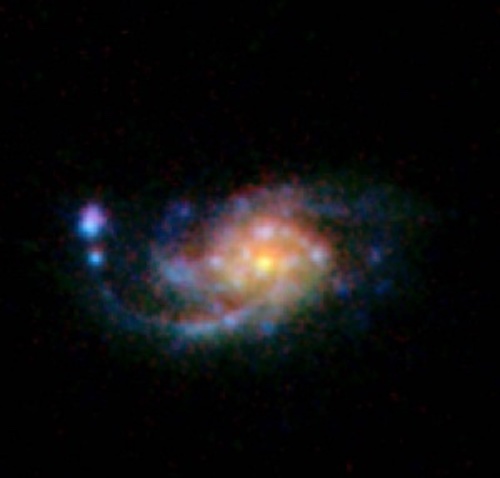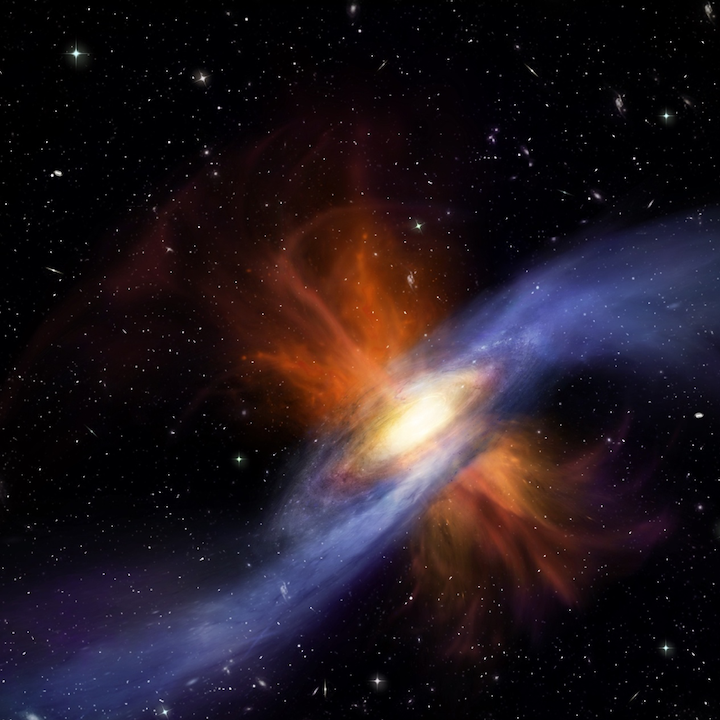20.06.2019

J165930+373527 IS AMONG THE GALAXIES DETECTED WITH COROTATING HALO GAS. THIS HIGH-RESOLUTION NIRC2 IMAGE (RED) COMBINED WITH HUBBLE SPACE TELESCOPE WFC3 IMAGING (BLUE AND GREEN) RESOLVES THE GALACTIC DISK. THE GALACTIC ROTATION WAS MEASURED FROM W. M. KECK OBSERVATORY AND APACHE POINT OBSERVATORY EMISSION-LINE SPECTRA.
Corotation Found to be Typical, Suggesting Cool Halo Gas Prolongs Galaxy Growth
Maunakea, Hawaii – A group of astronomers led by Crystal Martin and Stephanie Ho of the University of California, Santa Barbara, has discovered a dizzying cosmic choreography among typical star-forming galaxies; their cool halo gas appears to be in step with the galactic disks, spinning in the same direction.
The researchers used W. M. Keck Observatory to obtain the first-ever direct observational evidence showing that corotating halo gas is not only possible, but common. Their findings suggest that the whirling gas halo will eventually spiral in towards the disk.
“This is a major breakthrough in understanding how galactic disks grow,” said Martin, Professor of Physics at UC Santa Barbara and lead author of the study. “Galaxies are surrounded by massive reservoirs of gas that extend far beyond the visible portions of galaxies. Until now, it has remained a mystery how exactly this material is transported to galactic disks where it can fuel the next generation of star formation.”
The study is published in today’s issue of The Astrophysical Journal and shows the combined results of 50 standard star-forming galaxies taken over a period of several years.
Nearly a decade ago, theoretical models predicted that the angular momentum of the spinning cool halo gas partially offsets the gravitational force pulling it towards the galaxy, thereby slowing down the gas accretion rate and lengthening the period of disk growth.
The team’s results confirm this theory, which show that the angular momentum of the halo gas is high enough to slow down the infall rate but not so high as to shut down feeding the galactic disk entirely.

METHODOLOGY
The astronomers first obtained spectra of bright quasars behind star-forming galaxies to detect the invisible halo gas by its absorption-line signature in the quasar spectra. Next, the researchers used Keck Observatory’s laser guide star adaptive optics (LGSAO) system and near-infrared camera (NIRC2) on the Keck II telescope, along with Hubble Space Telescope’s Wide Field Camera 3 (WFC3), to obtain high-resolution images of the galaxies.
“What sets this work apart from previous studies is that our team also used the quasar as a reference ‘star’ for Keck’s laser guide star AO system,” said co-author Stephanie Ho, a physics graduate student at UC Santa Barbara. “This method removed the blurring caused by the atmosphere and produced the detailed images we needed to resolve the galactic disks and geometrically determine the orientation of the galactic disks in three-dimensional space.”
The team then measured the Doppler shifts of the gas clouds using the Low Resolution Imaging Spectrometer (LRIS) at Keck Observatory, as well as obtaining spectra from Apache Point Observatory. This enabled the researchers to determine what direction the gas is spinning and how fast. The data proved that the gas is rotating in the same direction as the galaxy, and the angular momentum of the gas is not stronger than the force of gravity, meaning the gas will spiral into the galactic disk.
“Just as ice skaters build up momentum and spin when they bring their arms inward, the halo gas is likely spinning today because it was once at much larger distances where it was deposited by galactic winds, stripped from satellite galaxies, or directed toward the galaxy by a cosmic filament,” said Martin.
NEXT STEPS
The next step for Martin and her team is to measure the rate at which the halo gas is being pulled into the galactic disk. Comparing the inflow rate to the star formation rate will provide a better timeline of the evolution of normal star-forming galaxies, and explain how galactic disks continue to grow over very long timescales that span billions of years.
ABOUT ADAPTIVE OPTICS
W. M. Keck Observatory is a distinguished leader in the field of adaptive optics (AO), a breakthrough technology that removes the distortions caused by the turbulence in the Earth’s atmosphere. Keck Observatory pioneered the astronomical use of both natural guide star (NGS) and laser guide star adaptive optics (LGS AO) on large telescopes and current systems now deliver images three to four times sharper than the Hubble Space Telescope. Keck AO has imaged the four massive planets orbiting the star HR8799, measured the mass of the giant black hole at the center of our Milky Way Galaxy, discovered new supernovae in distant galaxies, and identified the specific stars that were their progenitors. Support for this technology was generously provided by the Bob and Renee Parsons Foundation, Change Happens Foundation, Gordon and Betty Moore Foundation, Mt. Cuba Astronomical Foundation, NASA, NSF, and W. M. Keck Foundation.
ABOUT NIRC2
The Near-Infrared Camera, second generation (NIRC2) works in combination with the Keck II adaptive optics system to obtain very sharp images at near-infrared wavelengths, achieving spatial resolutions comparable to or better than those achieved by the Hubble Space Telescope at optical wavelengths. NIRC2 is probably best known for helping to provide definitive proof of a central massive black hole at the center of our galaxy. Astronomers also use NIRC2 to map surface features of solar system bodies, detect planets orbiting other stars, and study detailed morphology of distant galaxies.
ABOUT LRIS
The Low Resolution Imaging Spectrometer (LRIS) is a very versatile visible-wavelength imaging and spectroscopy instrument commissioned in 1993 and operating at the Cassegrain focus of Keck I. Since it has been commissioned it has seen two major upgrades to further enhance its capabilities: addition of a second, blue arm optimized for shorter wavelengths of light; and the installation of detectors that are much more sensitive at the longest (red)wavelengths. Each arm is optimized for the wavelengths it covers. This large range of wavelength coverage, combined with the instrument’s high sensitivity, allows the study of everything from comets (which have interesting features in the ultraviolet part of the spectrum), to the blue light from star formation, to the red light of very distant objects. LRIS also records the spectra of up to 50 objects simultaneously, especially useful for studies of clusters of galaxies in the most distant reaches, and earliest times, of the universe. LRIS was used in observing distant supernovae by astronomers who received the Nobel Prize in Physics in2011 for research determining that the universe was speeding up in its expansion.
ABOUT W. M. KECK OBSERVATORY
The W. M. Keck Observatory telescopes are the most scientifically productive on Earth. The two, 10-meter optical/infrared telescopes atop Maunakea on the Island of Hawaii feature a suite of advanced instruments including imagers, multi-object spectrographs, high-resolution spectrographs, integral-field spectrometers, and world-leading laser guide star adaptive optics systems. The data presented herein were obtained at the W. M. Keck Observatory, which is operated as a scientific partnership among the California Institute of Technology, the University of California, and the National Aeronautics and Space Administration. The Observatory was made possible by the generous financial support of the W. M. Keck Foundation. The authors recognize and acknowledge the very significant cultural role that the summit of Maunakea has always had within the Native Hawaiian community. We are most fortunate to have the opportunity to conduct observations from this mountain.
Quelle:Keck Observatory
